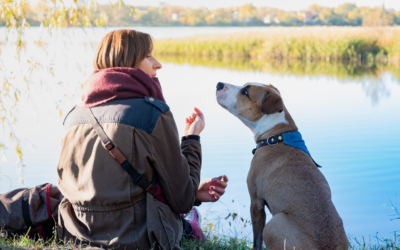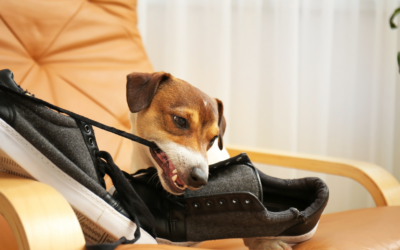Have you ever wondered WHY your pet does something they do?
As a Certified Applied Animal Behaviorist, this is probably the question I get asked the most. Often, we want to know why an animal does something that may worry or bother us, so that it can be changed.
In ethology (the science of animal behaviour), there are 4 main ways of looking at why an animal performs a behaviour. These were first described by Niko Tinbergen in 1963 in a paper called ‘On the aims and methods of ethology’
The four main reasons why an animal may be behaving the way it does are:
- How genetics influence behaviour – Phylogeny
- How early development and experience influence behaviour – Ontogeny
- What happens before the behaviour occurs – Causation
- What happens after the behaviour or the consequence – Function
Let’s dig into some of the science behind these.
Phylogeny (genetics)
Your pet’s genetics can affect many aspects of their behaviour. Our dogs and cats are descendants of their wild ancestors, and many of the behaviours we see in them today are still influenced by those genetics.
When looking to add a cat or dog to your household, oftentimes the breed of the dog is used to try to help guess at what the personality of your new pet will be. This can even be differences within a breed, such as dogs that might have been bred more for shows, or for hunting. Access to genetic testing has also let us find out even more about our pets.
Genetics are often used to explain certain behavioural traits like an Australian Shepherd or Border Collie running around behind children and possibly nipping at heels or trying to herd them, or a Ragdoll cat being placid and quiet.
Recent research has found that the specific genetics in one particular animal, such as the dog living in your home, is responsible for about 9% of the behaviour you see. Some traits are more tightly tied to breed, such as response to cues, playing with toys, and sociability. So, while genetics and breed can be important factors, they don't necessarily guarantee the animal in your home will behave the way you expect from that breed.
Ontogeny (changes due to development)
Ontogeny is behaviour caused by experiences your pet may have had, good or bad. This behaviour is influenced by what your animal has learned while they’re growing up.
For this reason, knowing the history of your dog or cat can be helpful. In many cases, this isn’t always possible, and even young puppies and kittens coming into your home have had many, many experiences already before they join your family. Some of these changes can even happen before an animal is born, with their mother’s stress affecting many behaviours as adults, as well as learning ability.
One important part of ontogeny is the socialization period, a very important period of time during development where animals learn about new experiences. During this time, positive exposure to people, other animals, environments, noises, and other situations is very important to help prevent fear later in life. In dogs, this period is from 3 weeks of age to somewhere between 12 and 16 weeks of age; in cats it is between 2 and 7 weeks of age, and possibly a bit longer than that.
You’ll notice that behaviour changes as an animal ages, the playing, biting and other behaviour that puppies and kittens have gradually decreases as they age to a generally more mature behaviour.
Function (consequence of behaviour)
There are two ways of looking at function – the immediate consequences of a behaviour (for example, eating dinner so that you are no longer hungry), or the ultimate function, which is more of a population-level and looks at how that behaviour helps the next generation or future of that species (eg an animal building a nest to ensure the survival of the babies). In our pets, we control much of the ultimate function and their reproduction, so the focus here is more on the immediate function.
When looking at our pets, function can be very important as it can be responsible for what is encouraging or discouraging a behaviour. We can,either accidentally or on purpose, make use of the function of a behaviour by what happens after your pet does it.
For example, if we reward a dog for coming when called fairly regularly, it makes them more likely to come the next time.
The alternative is also possible, and we can accidentally be encouraging a behaviour we may not want. For example, if you have a cat that meows in the morning to wake you up and you get up and feed your cat, you’re encouraging that behaviour. If your cat is then meowing in the morning, then the function of that behaviour is to get you up to get fed.
Causation (what happens before the behaviour)
Causation looks at what is happening inside the animal as well as what’s happening around the animal that affects behaviour. Internal factors could be an emotion like fear, or hormones driving behaviour. Outside of the animal, it could be something in their environment like a noise, or seeing another dog which might change their behaviour.
In behaviour modification and in training, this is one we look at A LOT.
Looking at the external factors can be important in something like separation anxiety. When working with pets that have this, we try to figure out all of the cues that a pet might be taking in that lets them know their people are going to be leaving the house. For some pets, this might be one of the last steps, such as grabbing the keys and heading out the door. For others, they may notice things you regularly do an hour before you leave and they could start to become anxious.
Another example is looking at the internal factors that cause your pet to act the way they do. In many of the dog reactivity or aggression cases I see, the underlying cause of the behaviour could be fear, even though it often doesn’t look that way to many people. Going through a careful history and looking at the various events that cause a behaviour to happen can help to figure out what is going on.
How do we use this information to help with dog or cat behaviour and training?
If you’re working with a behaviour professional, they should be taking a good history and asking questions about your dog or cat, their behaviour, their experiences, and more. This helps to start to look at some of the reasons why a behaviour might be happening.
It’s also important to know that what you’re doing with your dog or cat may, or may not have, resulted in the behaviour you see. Some of it is likely due to the environment they’re in, including the other animals and people in their home and their daily life. Training methodologies, how you react to their behaviour, and how you manage them can also affect behaviour. However, there are also so many factors that you haven’t influenced, such as their early experience, their genetics, their personality, and the neurochemical profile of that animal.
I find it helpful to take video when there is a behaviour or training issue, so that you can see what is happening around your pet as well as what happens after a behaviour, and it can often help you to change up some of those and see if the behaviour can be changed as well.
If you do have a behaviour problem with your pet, working with a behaviour professional to help you manage the problem and work on behaviour modification can help a lot.
If you’re interested in more of the science behind this blog post, visit The Behaviory Blog which is my blog written for pet professionals, and covers the topic in greater depth.
Want to hear about new blog posts and science-based information? Sign up below.



